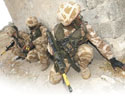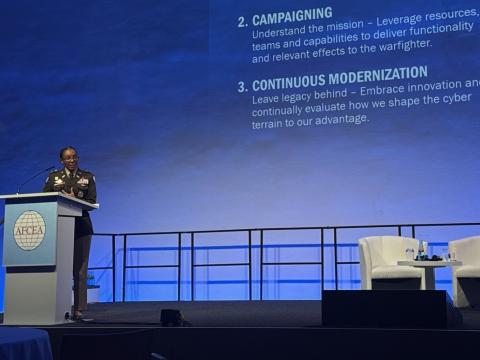British Competitors Craft Urban Warfare Capability
 |
| Four British service members take part in a simulated attack on a village during exercise Lion Sun 2005. The Ministry of Defence Grand Challenge is designed to yield a system that would protect U.K. troops as they conduct urban warfare. |
The
Entrants of the competition can present any kind of technical solution that would detect threats that troops could encounter in a village or urban site, including snipers concealed on roof tops, civilian vehicles mounted with heavy weapons, rocket-propelled grenades and improvised explosive devices. Systems should be mostly to fully autonomous and require little operator effort. Solutions also must be lightweight and easy to access with a low acoustic and visual signature. In addition, the tools should be either easily replaceable or highly resistant to countermeasures.
In mid-May potential competitors—limited to U.K.-based companies, research facilities and universities—submitted proposals that outlined the solutions they would pursue. In June teams were selected for participation based on the strength of the proposed system design, although Ministry of Defence (MOD) personnel have said that cost effectiveness also was a criterion.
Some participants will receive funding ranging from several thousand to several hundred thousand pounds from the MOD upon completion of their competition entries, while others are funding their own solutions. Both types of teams will compete in the finale in summer 2008. The winning team could receive funding for development and fielding.
The event’s location has not yet been determined; however, MOD planners say it probably will be held at Copehill Down, a military training site in
Fulfilling all the MOD’s system requirements is a tall order. However, Peter Mallinson, a business development manager with Roke Manor Research Limited in Romsey,
Dr. Julia Richardson, director of Stellar Research Services Limited, Southampton,
Mallinson views the time constraints as driving the Grand Challenge participants toward systems integration. “If the challenge were not constrained by a 12-month period of development, then you would do more building up from the ground … You’d tailor the solution more closely to what the troops require,” he relates. In some cases, teams may have to make choices about systems integration that they would not have made if they had more time. “The challenge is how you fix together the commercial off-the-shelf equipment and bring a lot of innovation into it to actually make it work. That’s a huge challenge, and that’s not to be underestimated,” Mallinson observes.
At the end of the development year, the competitors will demonstrate their systems during a two-week meet. Each team will receive information about the reconnaissance mission, including a scripted verbal briefing and hard-copy schematics, on the day of the demonstration. Less than 30 minutes after the briefing, the team must deploy its solution to detect threats in the mock village. The mission will last no longer than one hour, including the time it takes to generate output, which will be received by a service member on the judges’ panel acting as the mission’s tactical commander.
The judges’ panel, consisting of independent evaluators, will assess each team’s system based on the number of threats detected, identified and located; the number of false alarms raised; the need for operator intervention in information processing; and the need for operator intervention in platform operation. Hostile forces will populate the village, but the MOD has not determined whether forces will be real or simulated.
 |
| The remote-controlled SWORDS, or Special Weapons Observation Reconnaissance Detection System, is demonstrated at Copehill Down, a facility for training U.K. troops in urban operations. Grand Challenge participants may use robotic vehicles to meet the competition’s goal of achieving an autonomous system for detecting threats in an urban environment. |
Lord Paul Drayson, minister of state for defense equipment and support and the leading force behind the MOD Grand Challenge, has noted that the contest is modeled on the U.S. Defense Advanced Research Projects Agency’s (DARPA’s) Grand Challenge, an autonomous vehicle competition that will be held for the third time in November. “DARPA’s experience has proved that setting world-class technology challenges to a broad community really does reap results,” he said in his speech launching the MOD Grand Challenge. However, the two competitions differ in that the DARPA Grand Challenge calls for a specific type of system, an unmanned ground vehicle, whereas the
Mallinson believes that the Grand Challenge format as a competition will be more effective in producing solutions than the traditional bid process. “It’s bringing forward the ideas, and the problem with a lot of the traditional cycles is they bring forward only people who are familiar with the contracting process,” he points out. Mallinson adds that it may be difficult for some companies, especially smaller ones, to engage with large MOD programs.
The Grand Challenge is an example of changes brought about in the MOD by the Defence Technology Strategy, a government initiative that outlines MOD research and development priorities and encourages the involvement of industry and academia in innovation. Another project that has emerged from the Defence Technology Strategy is the Competition of Ideas, a program that funds promising solutions to specific technical challenges for
Dr. Tony Dodd, lecturer in aerospace systems engineering at the
In addition, as a university team, the group would have found it difficult to recruit personnel and pay them to perform work on the project without guaranteed funding from the MOD, which pays teams either at completion of the program or in stages. But to receive funding in stages, additional information was required in the proposal. Dodd expects that with more contracting experience and more time to prepare the bid, these difficulties could have been overcome.
The winner of the Grand Challenge will be selected based on performance during the finale. Unlike DARPA’s Grand Challenge, which includes grand prize money in the millions of dollars, the winner of the
Other participants will receive Commendation Citation Awards for technical excellence or innovation in categories such as subsystem design and overall system concepts. Contracting opportunities may result for teams as they demonstrate their technologies in front of the MOD and other potential customers.
If the Grand Challenge is successful in engaging the
Web Resources
MOD Grand Challenge: www.challenge.mod.uk
Competition of Ideas: www.ideas.mod.uk
DARPA Grand Challenge: www.darpa.mil/grandchallenge
Roke Manor Research Limited: www.roke.co.uk




Comments